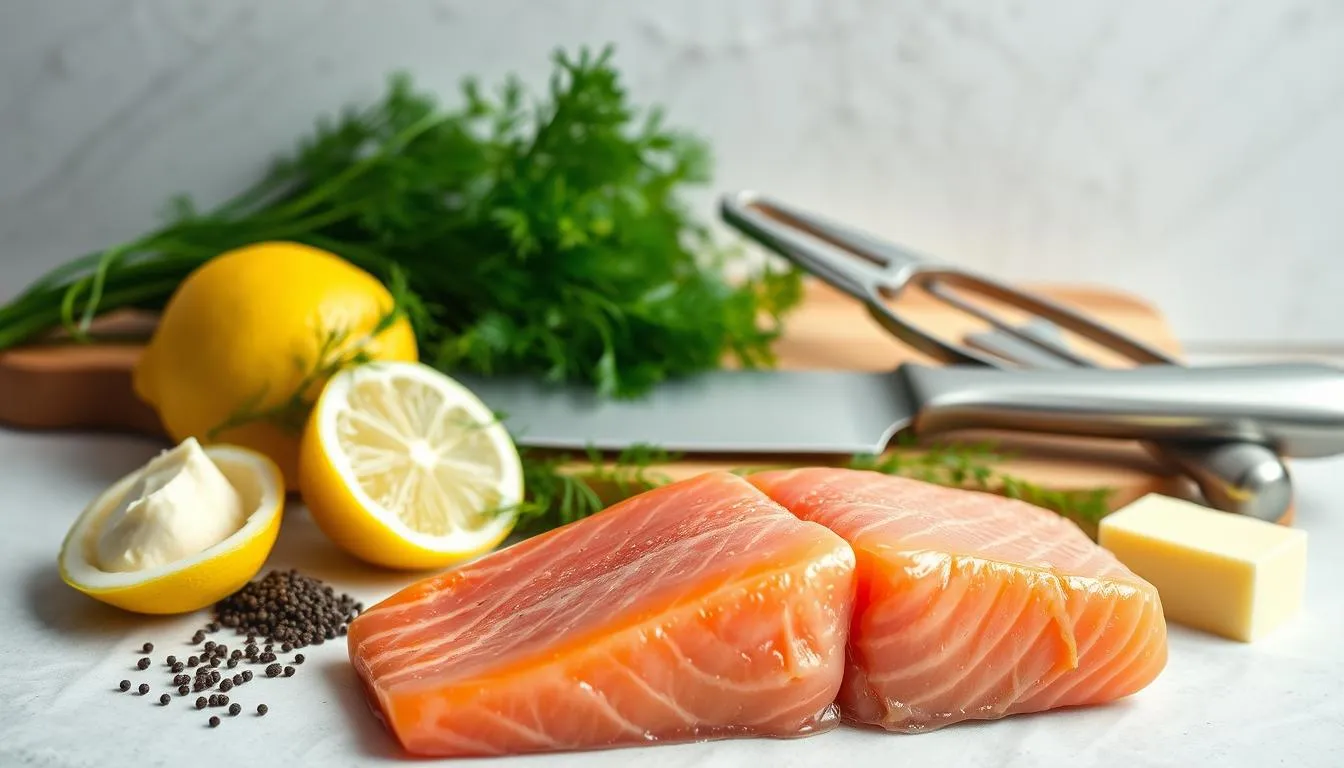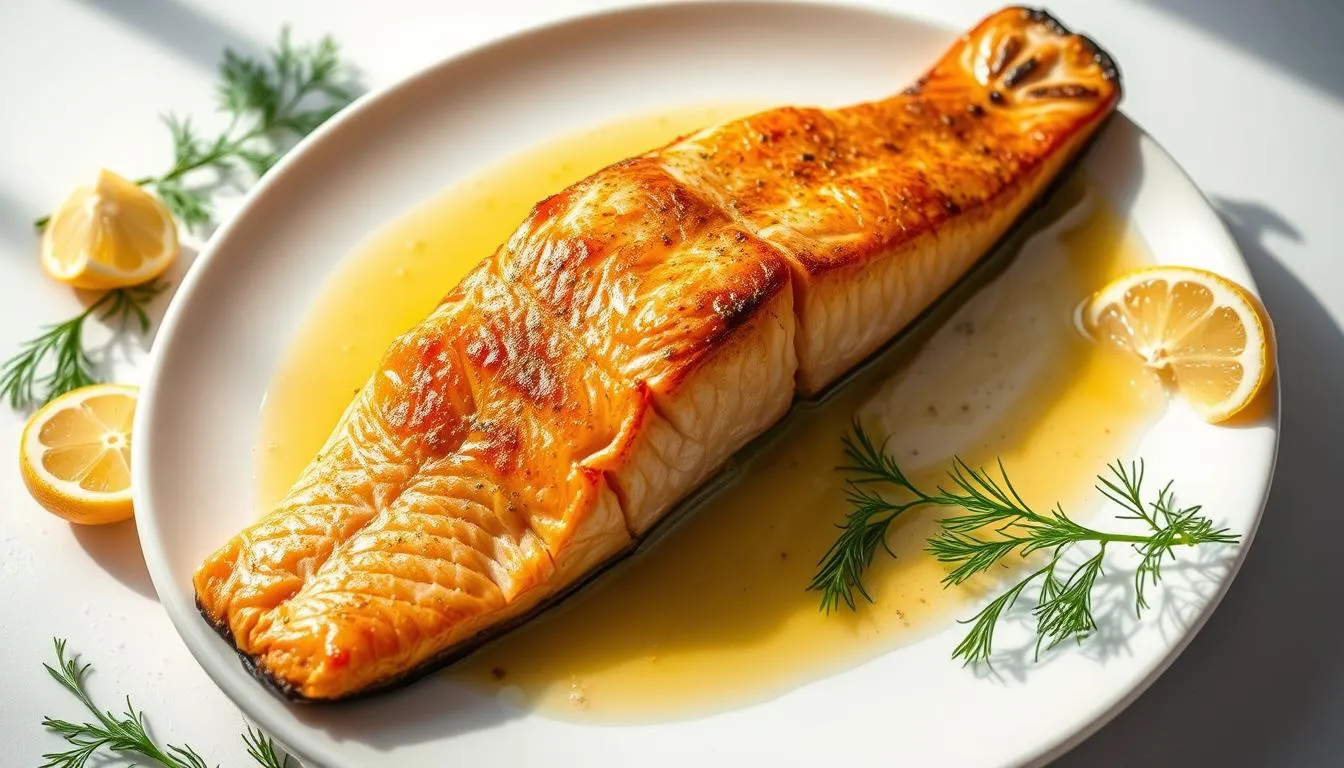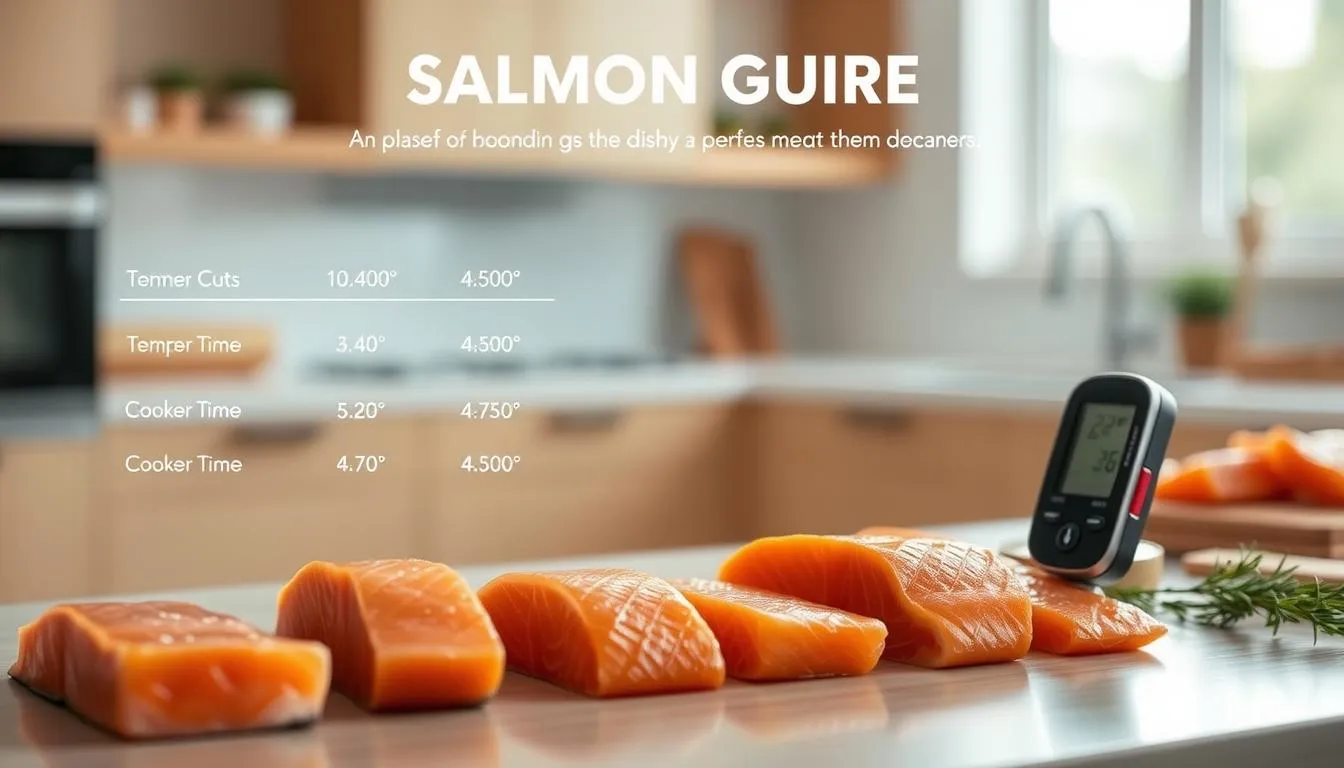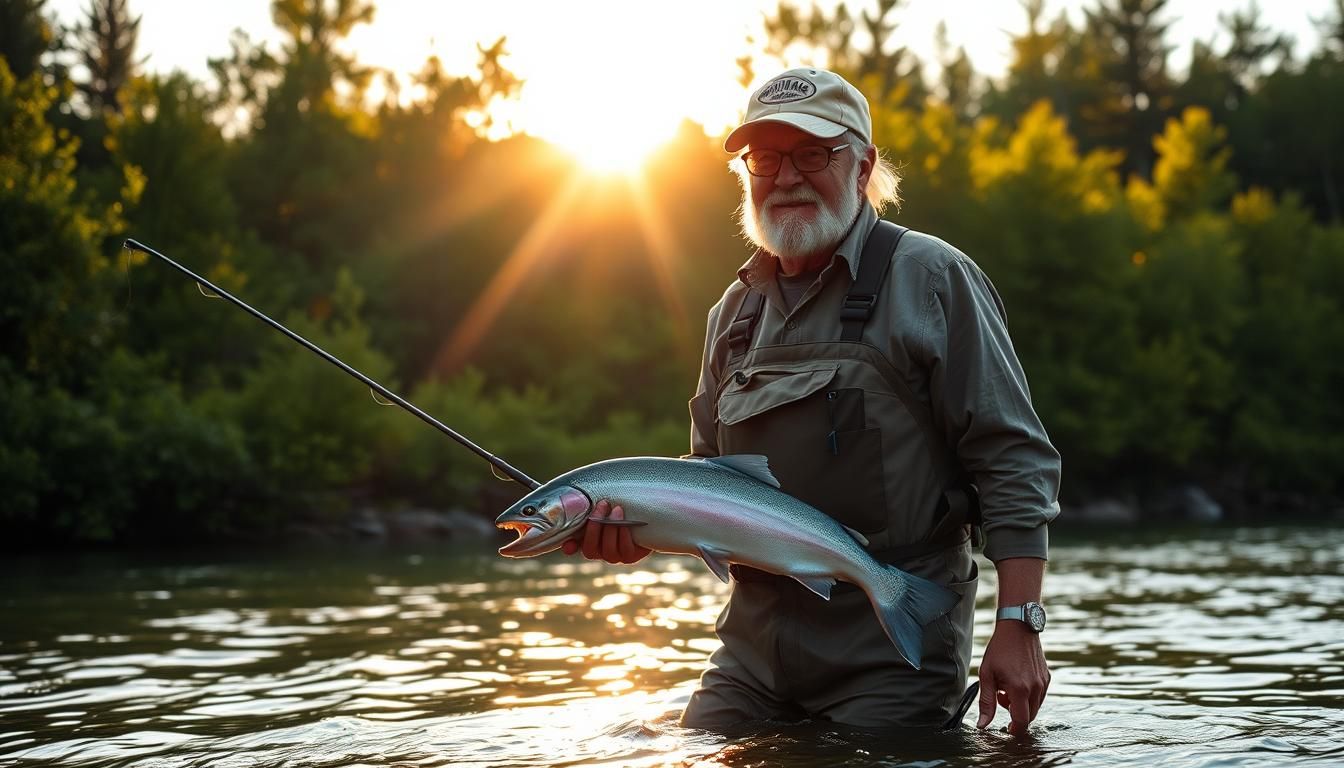I still remember the first time a weeknight dinner felt effortless and special. The steam, the bright lemon, and the quick sizzle that made the whole kitchen feel like home.
This guide brings fast, flavorful weeknight meals that land on the table in minutes without losing taste or nutrition. You’ll learn three core techniques—skillet, oven, and sheet-pan—that keep the flesh moist and the exterior caramelized.
We’ll cover pantry basics like olive oil, salt, and a few smart tools so timing and doneness are foolproof. Expect simple seasoning ideas from garlic to umami-forward glaze, plus easy sides that scale for one or a crowd.
Key Takeaways
- Fast, weeknight-friendly approaches that work in minutes.
- Three techniques—skillet, oven-baked, sheet-pan—for reliable results.
- Simple pantry items and clear doneness cues to protect delicate flesh.
- Flavor balance from lemon and garlic to bolder sauces.
- Scalable methods for quiet dinners or hosting friends.
Why Salmon Recipes Are Perfect for Quick, Healthy Dinners
Busy evenings call for a simple, flavorful main that comes together in minutes without fuss. This fish cooks fast, so you spend less time over the stove and more time enjoying dinner.
Healthy fat keeps the flesh moist and forgiving, so even imperfect timing still yields a tender, tasty dish. That makes it an ideal meal when you need reliable results on a tight schedule.
You can sear on the stovetop, roast in the oven, or use a sheet-pan — each way is quick and low-stress. Many baked salmon approaches are hands-off, freeing you to prep a side while the main cooks. For more healthy cooking techniques that preserve nutrients, explore our guide to water-based cooking methods.
- Minimal tools and easy cleanup — foil or parchment help contain juices.
- Simple accents like lemon and garlic build big flavor fast.
- Portions scale well for one or a family, reducing time and waste.
Once you learn one reliable recipe, you’ll have a go-to that adapts to what’s in your fridge and keeps weeknights simple and satisfying.
Essential Ingredients and Tools for Weeknight Salmon
Stocking a few smart pantry items and tools makes weeknight fish dinners quick and reliable.
Keep these ingredients on hand: garlic, honey, soy sauce, vinegar, olive oil, butter, and lemon. These staples add fast flavor and form the base of many sauce and glaze ideas.
Salt and freshly ground pepper finish the fillet just before cooking. A moderate smoke point oil supports even browning and steady heat during searing or baking.

Must-have equipment
A reliable nonstick pan gets an even sear without sticking. A sturdy sheet pan handles larger portions and hands-off oven baking.
Foil and parchment paper cut cleanup time, help contain juices for pan sauce, and prevent sticking while baking.
An instant-read thermometer removes guesswork on temperature and ensures juicy results in minutes.
| Item | Purpose | Tip |
|---|---|---|
| Garlic & Lemon | Brighten sauces and marinades | Add acid late to keep flavors fresh |
| Nonstick pan | Sear and finish fillets | Preheat, then add oil for even color |
| Sheet pan & foil/paper | Oven baking and easy cleanup | Line pan to trap juices and baste |
| Instant-read thermometer | Check internal temperature | Measure at thickest part for accuracy |
Quick notes: Match fillet thickness to cooking time — thinner pieces finish faster, thicker cuts give more leeway for searing and baking. These simple items let you move from skillet to sheet pan methods with little fuss.
Pan-Seared Honey Garlic Salmon (15 Minutes, Skillet Method)
A quick skillet method brings a glossy honey-garlic glaze to the table in about fifteen minutes. This approach balances sweet, salty, and bright notes so the finish is sticky but not cloying.
Make the honey-garlic sauce: whisk 4 tbsp honey, 2 tbsp soy sauce, 1 tbsp white vinegar, and 1 large minced garlic clove.
Pat the fillets dry and season with salt and pepper. Heat a drizzle of oil in a nonstick pan over steady medium-high heat.
Sear timing
Sear 3–4 minutes on the first side until golden, then flip and sear 2–3 minutes on the second side. This builds color before adding the glaze.
Caramelize and adjust
Pour the sauce into the skillet and cook about 1 minute until it begins to thicken and cling. If it tightens too fast, add 1 tbsp water at a time to loosen.
Finish and garnish
Pull the fish at roughly 120–130°F depending on preference; carryover heat will finish it. Sprinkle sesame seeds and sliced chives or scallions before serving.
| Step | Action | Tip |
|---|---|---|
| Sauce | Whisk honey, soy, vinegar, garlic | Use light soy for a cleaner balance |
| Sear | 3–4 min first side, 2–3 min second | Thin film of oil, don’t overcrowd |
| Adjust | Add water 1 tbsp if glaze thickens | Keep texture glossy, not brittle |
| Finish | Garnish with sesame & chives | Serve with broccolini or mashed potatoes |
Baked Salmon with Garlic Butter (12–15 Minutes at 400°F)
A quick bake at high heat delivers tender flesh and a bright garlic-lemon finish. Rest the fillet 20–30 minutes at room temperature for even cooking.
Preheat the oven to 400°F and line a sheet with foil. Lightly spray or brush with olive oil, then place the fillets skin side down.

Make the garlic butter
Stir together 3 tbsp melted butter, 2 tsp lemon juice, and 4 minced garlic cloves. Spoon the mix generously over the flesh so it clings during baking.
Timing and doneness
Bake for about 12–15 minutes. Aim for 120–130°F at the thickest part for medium-rare to medium; remove a few degrees early, since carryover raises the temperature.
Check doneness with a fork by pulling gently at the thickest part — the fish should flake and look gently opaque.
- Season with salt and pepper right before baking to avoid drawing moisture out.
- Keep the skin on to protect the fillet and make serving easier; slide a spatula under the flesh after baking if you prefer not to eat the skin.
- A light brush of olive oil on exposed areas helps prevent drying and improves finish.
Note: The USDA recommends 145°F, but many cooks prefer the lower range for a juicier result. This simple recipe works for individual fillets or a family-size piece and shines with extra lemon wedges at the table.
Sheet Pan Lemon-Herb Salmon (Hands-Off, Crowd-Pleaser)
A sheet-pan roast transforms a large fillet into a low-effort, crowd-pleasing dinner. Start by lining a sheet with foil, then top with parchment paper to prevent any lemon-foil reaction.
Nestle thin lemon slices on the paper, then set the fillet over them and season with salt and pepper. In a small bowl whisk melted butter, chopped garlic, honey, and fresh herbs into a loose drizzle that will bake into a glossy sauce.
Assembly and bake
Pour the drizzle evenly over the piece so it coats the flesh. Fold the foil and paper edges up to make a shallow barrier that traps juices for spooning at the table.
Timing and storage
Preheat oven to 350°F and roast—expect about 25 minutes for a large (~3 lb) fillet. Check the thickest part for flake; many cooks aim for 145°F for doneness. Keep skin on to support the fish and peel it off after baking if you prefer.
- Create a nonstick surface with foil + parchment; lemon underneath keeps the underside moist.
- Swap a touch of light brown sugar for extra sweetness if you like more caramelization.
- Refrigerate leftovers in an airtight container for up to three days for salads or bowls.
For a zesty variant, try the baked lemon-garlic butter fillet linked here: baked lemon-garlic butter fillet. This is an easy way to feed a group while keeping prep and cleanup simple.
Time, Temperature, and Doneness: How to Cook Salmon Perfectly
Getting doneness right is mostly about matching cook time to thickness and heat. Use minutes as a guideline, not a guarantee—thickness, starting temperature, and the pan or oven all change how long a fillet needs.

Skillet vs. oven: minutes per side and per thickness
Skillet baseline: for a 1-inch fillet, sear 3–4 minutes first side, then 2–3 minutes after flipping. Add sauce to the pan to caramelize, and thin it with a splash of water if it tightens too fast.
Oven baseline: standard fillets bake about 12–15 minutes at 400°F. A large single fillet often needs ~25 minutes at 350°F. These times assume moderate oven heat and room-temperature fish.
Thermometer guide
Insert the probe into the thickest part of the fillet to check the internal temperature. Many chefs pull at 120–130°F for medium-rare to medium.
Carryover cooking raises the temp a few degrees after removal, so stop a bit early. The USDA target is 145°F if you prefer a firmer finish—choose based on texture you like.
Fork test and visual cues
The classic fork test works: the flesh should flake easily and the outer layer looks opaque while the center can remain slightly coral for medium-rare.
| Method | Time guide | Tip |
|---|---|---|
| Skillet | 3–4 min / 2–3 min | Maintain steady heat; don’t crowd the pan |
| Oven | 12–15 min at 400°F or 25 min at 350°F | Check thickest part with thermometer |
| Resting | 2–5 minutes | Allows carryover finish; keeps it juicy |
- Fat content and cut shape change exact time—belly pieces may behave differently than tail sections.
- If a sauce is browning too fast, lower the heat and add water to avoid burning.
- When unsure, err on slightly under, rest briefly, then finish for 30–60 seconds if needed.
For detailed oven temperature guidance, see the best temperature for baking to match your preferred doneness.
Buying, Thawing, and Prepping Salmon Like a Pro
A few simple checks at the counter tell you whether a fillet will cook up bright and fresh.
Freshness checks: Look for a clean, ocean-fresh smell; any strong fishiness is a warning sign. The surface should spring back when pressed, and the flesh must be vibrant and even in color. For whole fish, clear, bright eyes and a firm body are classic quality markers.
Safe thawing
Thaw frozen pieces in the refrigerator overnight for best texture. For a quicker option, keep the fillets sealed in a bag and run cold water over them; never use hot water or heat to thaw.
Prepping tips
- Skip rinsing; pat fillets dry with paper towels to reduce splatter and help browning.
- Add salt just before cooking to preserve moisture; combine with freshly ground pepper at the last minute.
- Keep the skin on for oven cooking—it protects the part from direct heat and locks in juices.
- After cooking, slide a spatula between skin and flesh to remove it cleanly if you prefer a skinless plate.
- Aim for uniform thickness; fold the thin tail under to avoid overcooking that section.
“Buy only what you need for the day, or freeze promptly to keep quality at its best.”
| Check | What to expect | Why it matters |
|---|---|---|
| Smell | Mild, ocean-fresh | Strong odor = decline in quality |
| Texture | Flesh springs back | Indicates firmness and freshness |
| Thawing | Fridge or cold water bag | Protects texture and food safety |
Flavor Variations and Seasoning Ideas for Salmon Recipes
A few smart flavor twists make the same cooking method feel new each time. These small swaps use common pantry items and give you endless variety with little extra effort.
Cajun kick or fresh dill: For a zesty crust, brush fillets with olive oil and dust generously with Cajun seasoning, then bake as instructed for a toasty, bold finish. Prefer herbs? Use the garlic butter base, bake, then shower with fresh dill right after cooking for a bright, fragrant top note.
Sweetness and herb swaps: Swap honey for a few tablespoons of light brown sugar when you want molasses warmth and a thicker glaze. Mix thyme, rosemary, oregano, or parsley into finishing butter or marinades to change the mood of the dish.
Keep salt and pepper simple when a seasoning blend is strong. Layer garlic into a marinade or finishing butter to pair with lemon and herbs. Finish richer combinations with lemon zest and a squeeze of juice to brighten the plate without overpowering the fish.
Quick guide
| Variation | How to apply | Result |
|---|---|---|
| Cajun | Brush with olive oil, sprinkle seasoning, bake as usual | Spicy, toasted crust |
| Dill & garlic butter | Bake with garlic butter, add dill after cooking | Fresh, herb-forward finish |
| Honey vs brown sugar | Swap honey for light brown sugar in glaze | Richer, deeper sweetness and thicker glaze |
| Air fryer | Preheat to 400°F; cook 8–10 minutes | Crispy edges, tender center |
Tip: Blend pan juices with a knob of butter and lemon for a quick sauce that ties all these variations together. These tweaks slot into any base salmon recipe and keep weeknight cooking interesting.
Sides and Serving Ideas: Complete the Meal
A well-chosen set of sides turns a quick fillet into a full, satisfying meal. Bright greens and hearty starches balance richness and add texture to each bite.
Veggie pairings: Steamed broccolini or asparagus work well with pan-seared honey garlic salmon. Air fryer green beans crisp in about 10 minutes while the fish rests. For leafy crunch, quickly sauté bok choy or roast broccolini tossed in olive oil, salt, and pepper.
Starches that shine: Creamy mashed potatoes soak up skillet sauce. Herb-roasted potatoes and a fluffy rice pilaf also pair nicely with oven-baked fillets. For sheet-pan meals, spoon leftover juices over your sides to tie flavors together.
Storage tip: Refrigerate any extra in an airtight container for up to three days. Leftovers make an easy lunch bowl or salad topper. For creative ways to transform leftover salmon into delicious meals, see our guide to leftover salmon bowl ideas.
| Side | Cook time | Best use | Bonus tip |
|---|---|---|---|
| Broccolini | Roast 10–12 min | Bright, slightly charred | Don’t crowd the oven |
| Green beans (air fryer) | 10 min | Crisp-tender contrast | Toss with olive oil & lemon |
| Mashed potatoes | 20–30 min | Soaks up pan juice | Add a knob of butter |
| Rice pilaf | 15–20 min | Light, absorbent base | Finish with herbs |
For more healthy pairing ideas, see healthy side dishes to round out your next meal.
Conclusion
Master a few core techniques and simple pantry items to make weeknights taste like a treat. With skillet searing, oven roasting, and hands-off sheet-pan methods, you can rely on quick wins that fit real life.
With a few staples and clear steps, you’ll master salmon recipes and recreate favorite flavors anytime. From honey-garlic searing to garlic-butter roast, each recipe pairs speed with bold taste. Keep a thermometer, use the fork test, and watch visual cues to hit perfect doneness.
Finish plates with pan or tray juices and simple sides for a complete dinner. Save your favorites, note times for your oven, and enjoy a flexible rotation of baked salmon and other easy options. These tactics help you cook with confidence and serve meals everyone looks forward to.
FAQ
How long should I pan-sear a fillet for a medium doneness?
For a typical 1-inch thick fillet, sear the first side for 3–4 minutes over medium-high heat, then flip and cook 2–3 minutes more. Use an instant-read thermometer — aim for about 125°F to 130°F for medium, remembering carryover will raise the temp a few degrees after resting.
What oven temperature and time work best for baking a fillet?
Preheat the oven to 400°F for a reliable 12–15 minute bake for a standard fillet. Thicker pieces may need a few extra minutes; a large fillet around 1½ inches can take closer to 18–20 minutes at the same temp. Check doneness with a thermometer or the fork test.
Can I cook from frozen, and what’s the safest thawing method?
Yes, you can cook from frozen but it takes longer. For best texture, thaw in the refrigerator overnight or use the cold-water bag method (sealed bag submerged in cold water, change water every 30 minutes). Never thaw in hot water or at room temperature.
Should I cook with skin on or remove it before cooking?
Cook with the skin on for easier handling and crisp texture; it helps hold the fillet together and protects the flesh. If you prefer no skin, you can remove it after cooking — the flesh separates more cleanly once it rests.
What’s a quick sauce I can make in a skillet for a 15-minute meal?
Mix honey, soy sauce, minced garlic, and a splash of vinegar. After searing, remove the fillet, add the sauce to the hot pan, reduce until glossy, then return the fillet to coat. Thin with a tablespoon of water if it becomes too thick.
How do I keep the flesh moist when baking with garlic butter?
Pat the flesh dry, brush with a garlic-butter mix (melted butter, lemon juice, minced garlic), and bake right away. Don’t overbake — pull when internal temp hits 120–130°F for medium. Resting for a few minutes locks in juices.
What tools should I have for consistent results?
Keep a good nonstick skillet, a sheet pan, foil or parchment, and an instant-read thermometer. These items cut cleanup time and help you hit the right internal temperature every time.
How can I add variety without much extra effort?
Swap seasonings and sweeteners: try Cajun spice, dill, or a honey versus light brown sugar glaze. Add herbs like thyme or parsley, or roast on a sheet pan with lemon slices and a butter-garlic-honey drizzle for a different flavor profile.
What sides pair best for a balanced weeknight meal?
Quick roasted vegetables such as asparagus, broccolini, or green beans and a simple starch like rice pilaf or roasted potatoes complement the protein well. Use pan or sheet pan juices as a light finishing sauce for a cohesive plate.
Is an air fryer a good option and what settings work?
Yes — the air fryer is fast and gives crisp edges. Preheat to 400°F and cook 8–10 minutes for average fillets, flipping halfway if needed. Adjust time for thickness and check doneness with a thermometer.
